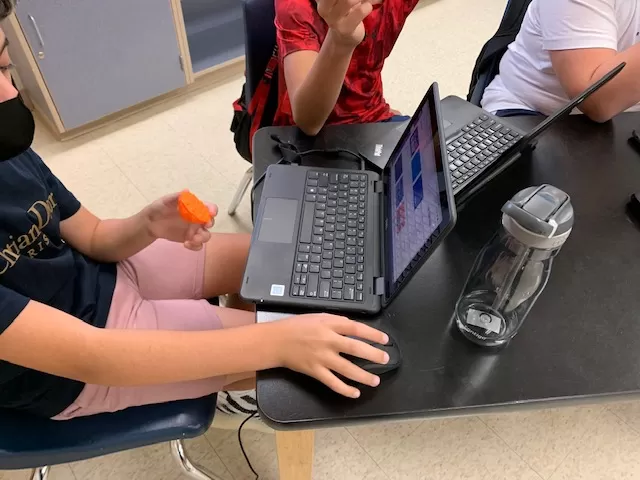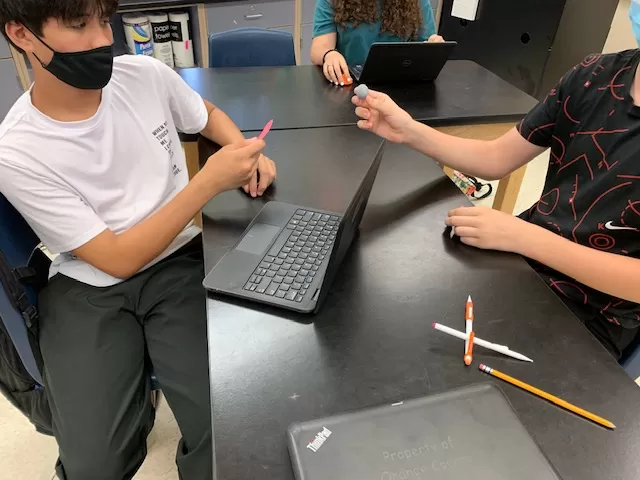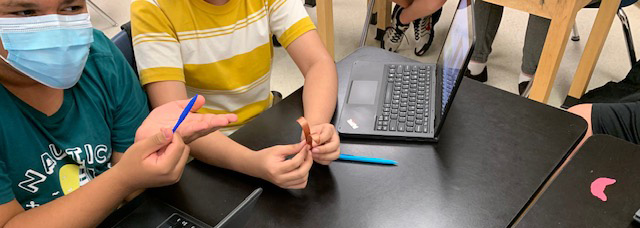Freedom Middle School - Orlando
3D Printed Models Boost Enthusiasm for Learning Science
A middle school science teacher uses MyStemKits activity kits to introduce her students to the wonders of science learning
Installation Snapshot:
MyStemKits (Chromosomes Kit, Darwin’s Finches Kit, Hominid Species and Tools Kit)
Benefits:
Increased student engagement • Improved understanding of difficult concepts • Deeper discussions on new information • Saves time with premade lessons
The Challenge
Meredith Williams, an 8th grade science teacher at Freedom Middle School (Orlando, FL), always tries to set her students up for success right at the start of the year by facilitating a discussion on three simple words, “What is it?” As a member of the science department, she aligns her vision with the Science Curriculum Department’s goal of helping Freedom MS students “learn the skills and strategies of proficient problemsolvers and scientifically literate citizens” as well as “strive to promote excellence and innovation in science teaching and learning for all.” To encourage her students to think critically and creatively about problems through science exploration, she incorporates a variety of manipulatives so that her students have something hands-on to observe, analyze, and form ideas around. With manipulatives and discussions – both in small groups and as a class – she shows her students that asking questions is a key component of science, as was the case at the start of this year. For the hands-on portion of the activity, she incorporates models printed using her 3D printer and MyStemKits lesson kits.
The Challenge
Meredith Williams, an 8th grade science teacher at Freedom Middle School (Orlando, FL), always tries to set her students up for success right at the start of the year by facilitating a discussion on three simple words, “What is it?” As a member of the science department, she aligns her vision with the Science Curriculum Department’s goal of helping Freedom MS students “learn the skills and strategies of proficient problemsolvers and scientifically literate citizens” as well as “strive to promote excellence and innovation in science teaching and learning for all.” To encourage her students to think critically and creatively about problems through science exploration, she incorporates a variety of manipulatives so that her students have something hands-on to observe, analyze, and form ideas around. With manipulatives and discussions – both in small groups and as a class – she shows her students that asking questions is a key component of science, as was the case at the start of this year. For the hands-on portion of the activity, she incorporates models printed using her 3D printer and MyStemKits lesson kits.
“As I walked around the room, I heard great ideas and reasoning. All levels of learners in my classroom were fully engaged and curious.”
Meredith Williams - 8th grade science teacher, on her observations as students worked with 3D printed materials
Key Solutions
MyStemKits is an online platform of STEM content and resources that supports the development of 21st-century skills like critical thinking and reasoning, communication and collaboration, and creative problem solving. MyStemKits has over 350 standards-aligned lesson plans for STEM hardware including 3D printers. Williams regularly incorporates 3D models and manipulatives to boost student participation in her science classes. As was mentioned, Williams starts the year with a short, inquiry activity using the Seed Dispersal Kit from MyStemKits. Unbeknownst to her students, she uses a timer to later show her students how involved a class discussion can get without opening a textbook or completing a worksheet. Before facilitating the lesson, Williams makes sure to have enough seeds printed from the Seed Dispersal Kit (one per student), in assorted colors such as red, yellow, blue, purple, white, orange, and silver.
She then follows these steps for this simple yet engaging activity:
- Group students in fours and hand each student a seed. There should be four different colored seeds per group. Do not provide students with any information about the seed.
- Without letting the class know, start running a timer.
- Ask the students, “What is it?” Tell them they have 5 minutes to examine their seeds and brainstorm ideas as a group of what the objects could be.
- After 5 minutes, open the discussion to the whole class. On the board, list the different ideas the groups came up with. Ideas tend to include bacteria, bugs and bug larvae, viruses (a popular one), ocean creatures, microscopic eggs of marine animals (i.e., plankton), alien species, and more.


Williams notes that none of her classes guessed seeds, however someone will eventually guess plants which leads to the following:
- When students say the items might be plants, ask, “Where do plants come from?” Usually, the initial response is “the ground” but that usually leads to “seeds.”
- Ask, “Why are the seeds so different?” and allow groups to discuss for a few minutes.
- Regroup as a whole class and talk about the items being seeds. Reinforce the following facts:
- Different seeds grow different plants that live in different places, and it is how the seeds move that directly affects their appearance.
- Seeds must be able to survive their environment and move locations, or animals move them.
- Engage students in a discussion about which seeds move by water, wind, animals, etc.
Close the activity by revisiting the original list of guesses (the ‘wrong answers’) and the question that started the activity – What is it? Then reveal the timer and point out the amount of time it took to answer that simple question. Williams says that this is her favorite part of the activity because she can emphasize that with science, the correct answer is rarely found the first time. She says, “Making mistakes and getting things wrong is part of the process but we never give up.” She makes it a point to ask if the process became so difficult that they gave up trying to think of an answer to the question. Williams notes that her students usually comment that the process was interesting because they wanted to know the answer. She explains to her classes that this is what science is all about – asking questions and discovering the answers to their questions.
Benefits
Besides providing materials, resources, and directions for creating models for her science classes, Williams appreciates how every learner in her class can benefit from the MyStemKits activities. She notes that all the different levels of learners are enthusiastic about getting involved in the activities. “As I walked around the room, I heard great ideas and reasoning. All levels of learners in my classroom were fully engaged and curious,” Williams states.
She says that for the past few years she has used this Seed Dispersal Kit activity to introduce her students to the dynamic possibilities of science and it has proven to be one that her students love. She comments, “It sets the tone for the class and opens their minds to think outside of the box.” Williams is helping her students develop problem solving skills connected to real-world challenges and that the MyStemKits lessons play a key role in that development.
“Welcome to science class! Science is not about being bored but about asking questions that advance our knowledge of the world around us.”
After introducing her students to science class using MyStemKits 3D printed models
Meredith Williams is a Boxlight Mimio Master specializing in the use of MyStemKits curriculum in her teaching. We look forward to hearing more from Meredith in the months ahead as she continues to implement MyStemKits activities, lessons, and design challenges.
Meredith has written numerous blogs with great lesson ideas like this one. See them all here.

.jpg)


